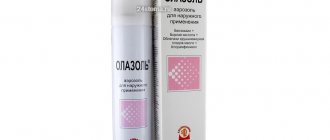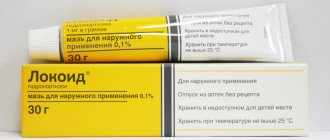Dex-gentamicin is an ophthalmic antibacterial agent that simultaneously relieves inflammation and avoids the spread of infection . This drug is available in the form of drops and ointments, and the second form is more popular, as it is highly effective in the treatment of pathologies of the visual organs.
Below you will find detailed instructions for use, beneficial properties of the drug, as well as reviews and analogues of the ointment.
Pharmacodynamics and pharmacokinetics
Pharmacodynamics
The drug Dex-Gentamicin contains two highly compatible active components in the optimal dosage of each of them.
Gentamicin is an antibiotic belonging to the group of aminoglycosides and is highly soluble in water. It has a pronounced bactericidal effect against a wide range of gram-positive and gram-negative microorganisms. It does not penetrate through the intact cornea. Inflammation and damage to the cornea of various origins create the possibility of penetration into the anterior chamber of the eye through the cornea 15 minutes after application of the drug.
Dexamethasone – has a strong anti-inflammatory and antiallergic effect. Penetration through the intact cornea into the anterior chamber of the eye, but when the corneal epithelium is damaged, the rate of penetration through the cornea increases.
Pharmacokinetics
Dexamethasone, when applied topically, quickly and well penetrates the tissue of the cornea and conjunctiva, reaching the required therapeutic concentration in the liquid medium of the eye.
Gentamicin sulfate , when applied topically in a therapeutic concentration in the liquid medium of the eye structures, is detected within 6 hours. The drug does not penetrate into the systemic circulation through the intact cornea.
Dex gentamicin analogues
The drug does not have equivalent structural analogs, but if it is impossible to use dex-gentamicin, you can replace it with other drugs similar in principle of action:
- Maxitrol . A combined action ointment that has antiallergic, anti-inflammatory and antibacterial effects. The basis of the product is a glucocorticosteroid and two antibiotics that are active against most pathological microorganisms that cause eye diseases.
- Prednisolone. A remedy for the treatment of eye diseases during the development of inflammatory processes. The drug also has an antiallergic effect. It is acceptable to use a drug that enhances regeneration processes for injuries to the organs of vision.
Contraindications
- Increased intraocular pressure ;
- Mycobacterial eye infections;
- Viral diseases of the conjunctiva and cornea ( dendritic keratitis , chicken pox );
- Fungal infections of the eyes;
- Purulent eye diseases that occur with damage to the corneal epithelium;
- Corneal epitheliopathy;
- High sensitivity to the drug.
When using the drug Dex-Gentamicin, it is not recommended to use contact lenses.
Additional recommendations
Attention! The ointment can cause temporary visual impairment, so immediately after applying it, you should refrain from work that requires precision and accuracy, and also do not drive a vehicle for at least 20-30 minutes.
Before applying the drug, you must remove contact lenses, if used. You can put them on again only after twenty minutes, when the medicine has completely dissolved.
Ideally, it is better to avoid wearing contact optics during the course of treatment.
Instructions for use (Method and dosage)
Dex-Gentamicin ophthalmic ointment in the form of a strip about 1 cm long is placed into the conjunctival cavity 2-3 times a day. At the same time, during the procedure it is necessary to avoid contact of the tube with the surface of the conjunctiva and skin. When prescribing the simultaneous use of several ophthalmic agents, the instructions for Dex-Gentamicin ophthalmic ointment indicate the need to maintain a time interval between their use of at least 15 minutes.
Dex-Gentamicin eye drops are instilled directly into the conjunctival sac in a dosage of 1-2 drops 5-6 times a day. Dexa-Gentamicin should not be used for more than 3 weeks.
special instructions
During treatment with Dex-Gentamicin solution, it is recommended not to use contact lenses.
When using them, with the permission of the doctor, before the instillation procedure, the correction means must be removed and installed again only after 20 minutes have passed after instillation.
Patients with a history of glaucoma should regularly monitor intraocular pressure.
Immediately after instillation of the Dex-Gentamicin solution, short-term visual impairment may occur, which leads to a slowdown in psychomotor reactions. Therefore, it is not recommended to instill the drug immediately before driving a car or working with moving mechanisms.
Store Dex-Gentamicin solution in a dark place at room temperature. Keep away from children.
The shelf life of the bottle is 3 years. After opening it, the solution should be used for no more than 6 weeks.
Analogs
Level 4 ATX code matches:
Sofradex
Garazon
Maxitrol
Tobradex
Betagenot ( gentamicin + betamethasone ), Tobradex ( tobramycin + dexamethasone ), Maxitrol ( neomycin + dexamethasone + polymyxin B ), Combinil-Duo ( ciprofloxacin + dexamethasone have a similar effect .
Note!
Description of the drug Gentamicin-Dexa drops. eye. fl. 5ml on this page is a simplified author’s version of the apteka911 website, created on the basis of the instructions for use.
Before purchasing or using the drug, you should consult your doctor and read the manufacturer's original instructions (attached to each package of the drug). Information about the drug is provided for informational purposes only and should not be used as a guide to self-medication. Only a doctor can decide to prescribe the drug, as well as determine the dose and methods of its use.
Reviews
This complex drug in the form of drops and ointments combines antibacterial and antiallergic effects. Judging by the reviews, it was prescribed for chronic conjunctivitis , blepharitis and blepharoconjunctivitis , in cases where allergic manifestations are combined with a bacterial infection. After all, it is known that with allergic conjunctivitis, sooner or later inflammation occurs, which is chronic. The drug is also effective for episcleritis , trauma to the conjunctiva and cornea, and keratitis . All patients note the high effectiveness of ointments and drops, which have a pronounced anti-inflammatory effect.
- “... The child had purulent conjunctivitis, which was treated for a month with sulfacyl and chloramphenicol drops. There was little result and the inflammation spread to the cornea. Dex-gentamicin ointment was prescribed. And we finally began to recover.”
- “...Dex-Gentamicin ointment was prescribed to me for demodicosis of the eyelids, when purulent inflammation developed. I lubricated it at night for 4-5 days - the inflammation went away.”
- “...Good ointment. She used it for ulcerative blepharitis: the purulent crusts disappeared after 2 days, and she treated ulcerations of the edges of the eyelids for another five days.”
- “...This ointment helped my husband quickly cure stye. He is very pleased with the effectiveness of the ointment.”
Many people were prescribed drops after ophthalmological operations, and they successfully prevented postoperative complications. All patients tolerated the drug well and no adverse reactions were noted.
Side effects of the drug
Some patients may experience the following side effects when using this medicine:
- herpetic keratitis;
- increased severity of bacterial infection of the cornea;
- perforation of the cornea (if the ointment is used for peratitis);
- development of secondary glaucoma and steroid cataract (only in case of long-term use);
- contact dermatitis;
- slowing down the regeneration processes of eye tissue, provided that the ointment is used after eye injuries;
- allergic reactions;
- burning sensation.
Such consequences may occur if there is intolerance to the components of the drug.
It is worth noting! In case of overdose, such side effects do not occur or are unlikely.
Price, where to buy
You can buy Dex-Gentamicin at any pharmacy. The price of Dex-Gentamicin eye ointment 2.5 g in Moscow pharmacies ranges from 107-185 rubles, and similar eye drops 5 ml can be purchased for 125-225 rubles.
- Online pharmacies in RussiaRussia
- Online pharmacies in UkraineUkraine
- Online pharmacies in KazakhstanKazakhstan
ZdravCity
- Dexa-Gentamicin eye drops 5mlUrsapharm Arzneimittel GmbH
RUB 156 order - Dexa-Gentamicin eye ointment 2.5 gUrsapharm Arzneimittel GmbH
RUB 156 order
Pharmacy Dialogue
- Dexa-gentamicin (ointment, 2.5 g tube) Ursapharm
RUB 141 order
- Dexa-gentamicin (eye drops 5 ml)Ursapharm
166 RUR order
show more
Pharmacy24
- Dexa-Gentamicin 5 ml drops Ursafarm Arznaimittel GmbH, Nimechchina
84 UAH.order
PaniPharmacy
- Dexa-gentamicin liquid Dexa-gentamicin h/c 5ml Germany, Ursapharm
99 UAH order
show more
Dexa-gentamicin eye drops 5ml fl-cap
Registration Certificate Holder
URSAPHARM Arzneimittel (Germany)
Dosage form
Medicine - Dexa-Gentamicin
Description
Eye drops
colorless, transparent.
1 ml
dexamethasone sodium phosphate 1 mg gentamicin sulfate 5 mg, which corresponds to the content of gentamicin 3 mg
Excipients
: benzalkonium chloride (preservative) - 0.05 mg, potassium hydrogen phosphate - 1.88 mg, potassium dihydrogen phosphate - 5.86 mg, sodium chloride - 5 mg, water for injection - up to 1 ml.
5 ml - polymer dropper bottles (1) - cardboard packs.
Indications
Infections of the anterior segment of the eye caused by microflora sensitive to gentamicin (conjunctivitis, keratitis, blepharitis, barley); allergic processes in the anterior segment of the eye, accompanied by bacterial infection; prevention and treatment of inflammatory phenomena in the postoperative period (after cataract removal and anti-glaucoma operations).
Contraindications for use
Keratitis caused by Herpes simplex and Varicella zoster viruses (dendritic keratitis); viral diseases of the cornea and conjunctiva (including chicken pox); fungal eye diseases; mycobacterial eye infections; acute purulent eye diseases with damage to the corneal epithelium; corneal epitheliopathy; injuries and ulcerative lesions of the cornea; increased intraocular pressure; I trimester of pregnancy; children and adolescents up to 18 years of age; wearing contact lenses; hypersensitivity to the components of the combination.
pharmachologic effect
Combined drug for local use in ophthalmology.
It has antiallergic, anti-inflammatory and antibacterial effects. Dexamethasone
- GCS, has antiallergic and pronounced anti-inflammatory effects. The index of its relative anti-inflammatory activity is 30.
Gentamicin
– an antibiotic of the aminoglycoside group, characterized by a wide spectrum of action. Active against most gram-positive and gram-negative microorganisms, incl. Pseudomonas aeruginosa, Escherichia coli, Klebsiella spp., Salmonella spp., Proteus spp., Serratia spp. Moderately active against Staphylococcus spp.
Drug interactions
When used together with atropine, other cholinergic drugs, and drugs that cause mydriasis, intraocular pressure may increase.
When applied topically, gentamicin is incompatible with amphotericin B, heparin, sulfadiazine, cephalothin and cloxacillin. Topical use of these drugs together with gentamicin may lead to the deposition of precipitates in the conjunctival cavity.
Dosage regimen
Used in the form of instillations or applications into the conjunctival sac. The dose and frequency of use depends on the dosage form used.
Side effect
Rarely:
allergic reactions, burning sensation in the eye after using the drug.
Maybe:
contact dermatitis, herpetic keratitis, perforation of the cornea in the presence of keratitis, fungal infection, increased severity of bacterial infection of the cornea, ptosis, mydriasis. Use after corneal injuries may slow down its healing. With long-term use - the development of secondary glaucoma and steroid cataracts.
special instructions
When using the drug for more than 2 weeks, as well as in patients with a history of glaucoma, it is recommended to regularly monitor intraocular pressure.
The patient should be informed that if side effects occur, treatment should be stopped immediately and contact an ophthalmologist.
Effect on the ability to drive vehicles and machinery
Immediately after using this combination, a short-term disturbance in visual acuity may occur, leading to a slowdown in psychomotor reactions. Therefore, it is not recommended to use the drug immediately before working with machinery or driving vehicles. For 30 minutes after instillation, you must refrain from activities that require increased attention.
Use during pregnancy and breastfeeding
Restrictions during pregnancy - Contraindicated. Restrictions when breastfeeding - With caution.
In the second and third trimesters of pregnancy and during breastfeeding, a drug containing this combination can be used when the expected benefit of therapy for the mother outweighs the potential risk for the fetus or child. Use is contraindicated in the first trimester of pregnancy.
Use in elderly patients
Restrictions for elderly patients - Use with caution.
Possible use in elderly patients according to indications.
Use in children
Restrictions for children - Contraindicated. Contraindicated in children and adolescents under 18 years of age.
Terms of sale
The drug is available with a prescription.







